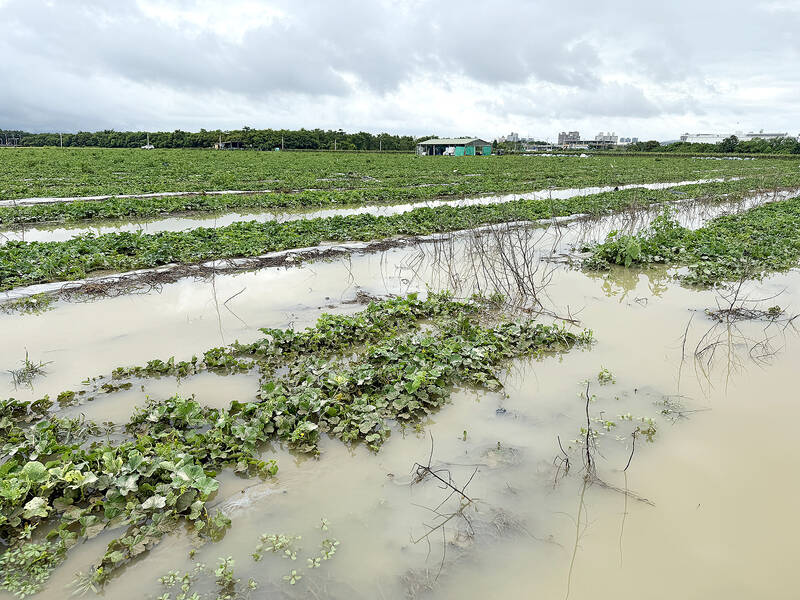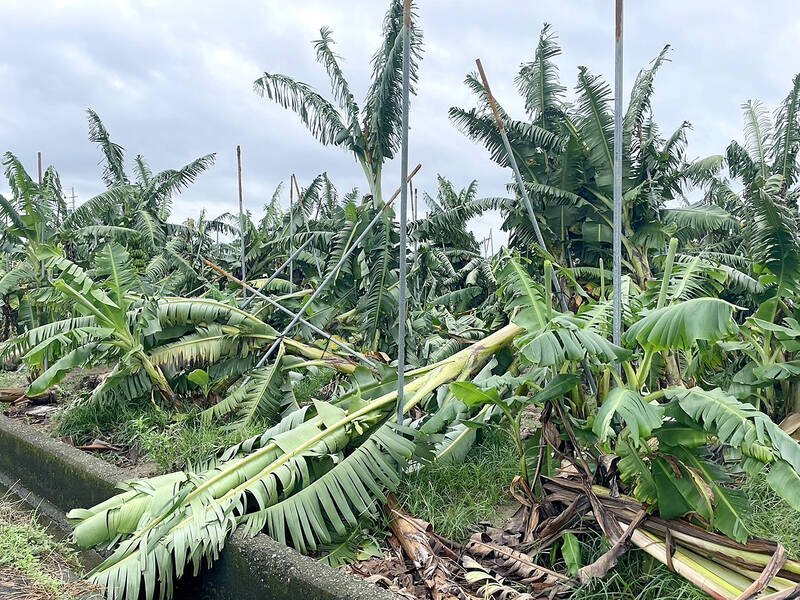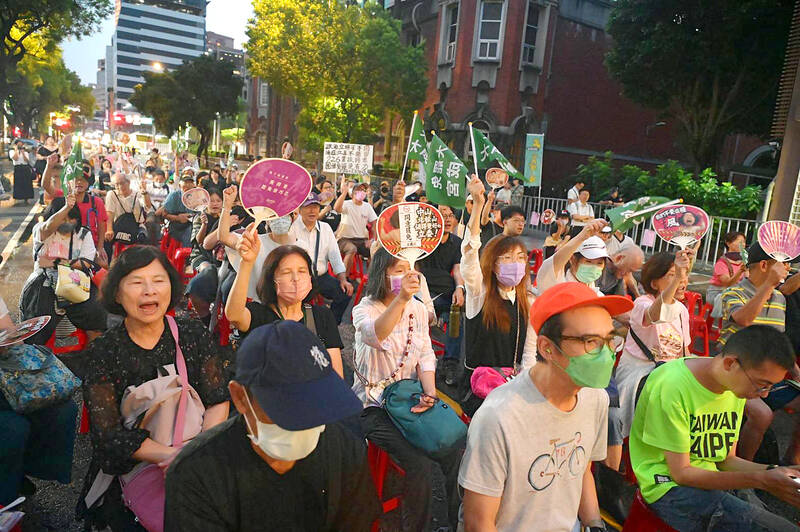Crop damage from Typhoon Danas “had covered 9,822 hectares of farmland, more than 1.5 percent of Taiwan’s arable land, with an average loss rate of 30 percent, equivalent to 2,977 hectares of total crop failure,” this paper reported on Thursday last week. Costs were expected to exceed NT$1 billion.
The disaster triggered clashes in the legislature last week between members of the Democratic Progressive Party (DPP) and China-aligned lawmakers from the Chinese Nationalist Party (KMT) and Taiwan People’s Party (TPP). DPP caucus chief executive Rosalia Wu (吳思瑤) argued that opposition lawmakers should take responsibility for slashing the Ministry of Agriculture’s (MOA) NT$90 million (US$3.09 million) budget earmarked for the agricultural special income fund. KMT Legislator Chang Chia-chun (張嘉郡) had originally proposed cutting the ministry’s budget to NT$1 during last year’s budget negotiations until public backlash forced the KMT and TPP to settle for merely slashing the fund.
Disaster relief may make headlines, but more fundamentally, the KMT-TPP cuts and freezes of the agricultural budget threated many key programs, “including landslide monitoring systems, disaster inspection protocols, African swine fever prevention measures and initiatives designed to promote Taiwanese agricultural products in international markets,” TVBS reported in March.

Photo: CNA
The news media has reported extensively on how the public anger driving the current recall campaign focuses on the defense budget cuts and the evisceration of governance. For example, Focus Taiwan, in an excellent explainer of the recalls, summarized the campaign thusly: “The current wave of recalls was initiated by civil society groups opposed to a series of legislative measures adopted by the KMT and the smaller Taiwan People’s Party (TPP), which opponents argue will undermine Taiwan’s constitutional order and weaken efforts to bolster defense capabilities against growing Chinese military threats.”
The backlash against the agricultural cuts shows how the less reported but still widespread effects of the budget destruction has generated public anger.
ORGANIZED RESISTANCE

Photo: CNA
Both local and international media have correctly identified the current recall campaign as a response by civil society groups, despite an intense KMT and TPP propaganda campaign to depict it as a partisan DPP program. Many observers have been surprised by the effectiveness of the campaign, and the devotion of its participants. To understand how a campaign like this could organize itself with such effectiveness, it is important to situate public anger and public action in the centuries of resistance to external power that has deep, abiding roots in collective social action throughout the Qing, Japanese and KMT colonial periods.
Han Cheung’s excellent four-part series in this paper on Hakka resistance to the Japanese during the 1895 invasion of Taiwan shows how local resistance can organize and extend across Taiwan spatially and socially. After defeat in the north, around Hsinchu “the Hakka militias led by Wu Tang-hsing (吳湯興) regrouped in the Jianbishan (尖筆山) mountains in today’s Jhunan (竹南), Miaoli County, their ranks bolstered by New Chu Army members sent from Changhua and Black Flag Army fighters from Tainan.”
Another example of this is the Tapani Incident (西來庵事件) of 1915, in which local Han and Indigenous leaders organized a rebellion against the Japanese in the mountains east of Tainan. This spirit would reappear in the anti-government uprising known as the 228 Incident in 1947, when Indigenous fighters from Alishan occupied Chiayi city.

Photo: Wang Yi-sung, Taipei Times
MEINONG DAM MOVEMENT
Armed rebellion is dramatic and obvious, but consider also the Meinong Dam protest movement in Kaohsiung’s Meinong District (美濃), one of the key movements of the 1990s, which eventually got the dam project killed. A wide-ranging paper by Tsai Shu-chen (蔡淑真) of Xiamen University and Lee Su-hsin (李素馨) at National Taiwan Normal University locates the Meinong Dam resistance in centuries of water-centered social organization, beginning in 1736 when Hakkas first moved across the Laonong River (荖濃溪) from Pingtung to Meinong. During the Qing Dynasty they organized their irrigation infrastructure around potential upstream disasters. When Typhoon Morakot struck the area in 2009, flooding was extensive in those areas developed by the Japanese and KMT colonial administrations, but not in farming areas originally laid out by the local farmers.
Since 1974, Tsai and Lee observe, Kaohsiung City and Gangshan Township (岡山) have relied for water on 13 deep-water wells located in Ligang Township (里港) in Pingtung. In 1987 Kaohsiung sunk five deep wells in nearby Shoujinliao (手巾寮) in Kaohsiung, opposed by the Ligang residents who quickly formed an association to stop the digging. Finally resolved in 1994 when the wells were shut-off, the stand-off grew so intense that at one point the Kaohsiung city government closed the roads leading into the city, cutting off Pingtung from Kaohsiung.
Hence, when the Meinong Dam resistance began, it could draw on long experience of local organization and resistance. After the dam was halted, the government in 2000 resurrected the project in a new guise, the Jiyang Artifical Lake, intended to offset water shortfalls in Kaohsiung. Again a resistance movement was organized and the project was eventually shelved. A deep water well project in Cishan (旗山) proposed by the Taiwan Water Corporation in 2014 similarly engendered a resistance program among locals.
GRIEVANCES EXPLODE
The ending of martial law in 1987 enabled pent-up social grievances to explode. Ho Ming-sho (何明修), the well-known National Taiwan University sociologist, chronicled resistance to naptha crackers in the post-martial law era.
For example, to fight a new naptha cracker in the Houjin community (後勁) outside Kaohsiung, local residents barricaded the entrance for three years beginning in July of 1987.
“The Houjin movement was one of the best-known environmental protests in the post-martial law era, and its violence, including several rounds of brutal confrontations with the police, revealed the magnitude of long-silenced discontent,” he describes. Similarly, he writes of a subsequent naptha cracker project of Formosa Plastics: “Formosa Plastics Group’s ambition to build an integrated petrochemical empire was thwarted by the rise of environmental protests that obliged it to shift its projected site from Wuchieh Township (五結), Yilan County, to Guanyin Township (觀音), Taoyuan County, and eventually to Mailiao Township (麥寮), Yunlin County.”
This ability to respond to external threats by organizing locally is latent across Taiwan. In recent years civil society has organized several times in response to threats from the People’s Republic of China (PRC). For example, the visit of PRC official Chen Yunlin (陳雲林) in 2008 triggered the Wild Strawberry movement which led to occupation of public spaces across Taiwan. The Sunflowers in their turn occupied the legislature in response to the now-dead cross-strait services pact.
At present, reacting to the KMT-TPP enabling of the PRC threat, civil society has birthed the recall movement. It is driven not by the partisan politics of the current blue-green divide, but by the spirit of resistance that sent Hakka warriors into the teeth of Japanese firepower in 1895, fired the peasant and labor union movement for land reform, eight-hour work-days, and home rule in the 1920s and 1930s, sparked the 228 revolt against the KMT, and powered decades of local environmental activism.
May that spirit never die.
Notes from Central Taiwan is a column written by long-term resident Michael Turton, who provides incisive commentary informed by three decades of living in and writing about his adoptive country. The views expressed here are his own.

Oct. 27 to Nov. 2 Over a breakfast of soymilk and fried dough costing less than NT$400, seven officials and engineers agreed on a NT$400 million plan — unaware that it would mark the beginning of Taiwan’s semiconductor empire. It was a cold February morning in 1974. Gathered at the unassuming shop were Economics minister Sun Yun-hsuan (孫運璿), director-general of Transportation and Communications Kao Yu-shu (高玉樹), Industrial Technology Research Institute (ITRI) president Wang Chao-chen (王兆振), Telecommunications Laboratories director Kang Pao-huang (康寶煌), Executive Yuan secretary-general Fei Hua (費驊), director-general of Telecommunications Fang Hsien-chi (方賢齊) and Radio Corporation of America (RCA) Laboratories director Pan

The classic warmth of a good old-fashioned izakaya beckons you in, all cozy nooks and dark wood finishes, as tables order a third round and waiters sling tapas-sized bites and assorted — sometimes unidentifiable — skewered meats. But there’s a romantic hush about this Ximending (西門町) hotspot, with cocktails savored, plating elegant and never rushed and daters and diners lit by candlelight and chandelier. Each chair is mismatched and the assorted tables appear to be the fanciest picks from a nearby flea market. A naked sewing mannequin stands in a dimly lit corner, adorned with antique mirrors and draped foliage
The consensus on the Chinese Nationalist Party (KMT) chair race is that Cheng Li-wun (鄭麗文) ran a populist, ideological back-to-basics campaign and soundly defeated former Taipei mayor Hau Lung-bin (郝龍斌), the candidate backed by the big institutional players. Cheng tapped into a wave of popular enthusiasm within the KMT, while the institutional players’ get-out-the-vote abilities fell flat, suggesting their power has weakened significantly. Yet, a closer look at the race paints a more complicated picture, raising questions about some analysts’ conclusions, including my own. TURNOUT Here is a surprising statistic: Turnout was 130,678, or 39.46 percent of the 331,145 eligible party

The election of Cheng Li-wun (鄭麗文) as chair of the Chinese Nationalist Party (KMT) marked a triumphant return of pride in the “Chinese” in the party name. Cheng wants Taiwanese to be proud to call themselves Chinese again. The unambiguous winner was a return to the KMT ideology that formed in the early 2000s under then chairman Lien Chan (連戰) and president Ma Ying-jeou (馬英九) put into practice as far as he could, until ultimately thwarted by hundreds of thousands of protestors thronging the streets in what became known as the Sunflower movement in 2014. Cheng is an unambiguous Chinese ethnonationalist,